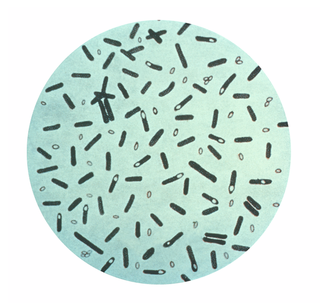
Clostridium botulinum is a Gram-positive, rod-shaped, anaerobic, spore-forming, motile bacterium with the ability to produce the neurotoxin botulinum.

Clostridium acetobutylicum, ATCC 824, is a commercially valuable bacterium sometimes called the "Weizmann Organism", after Jewish Russian-born biochemist Chaim Weizmann. A senior lecturer at the University of Manchester, England, he used them in 1916 as a bio-chemical tool to produce at the same time, jointly, acetone, ethanol, and n-butanol from starch. The method has been described since as the ABE process,, yielding 3 parts of acetone, 6 of n-butanol, and 1 of ethanol. Acetone was used in the important wartime task of casting cordite. The alcohols were used to produce vehicle fuels and synthetic rubber.
Cellulosomes are multi-enzyme extracellular complexes. Cellulosomes are associated with the cell surface and mediate cell attachment to insoluble substrates and degrade them to soluble products which are then absorbed. Cellulosome complexes are intricate, multi-enzyme machines, produced by many cellulolytic microorganisms. They are produced by microorganisms for efficient degradation of plant cell wall polysaccharides, notably cellulose, the most abundant organic polymer on Earth. The multiple subunits of cellulosomes are composed of numerous functional domains that interact with each other and with the cellulosic substrate. One of these subunits, a large glycoprotein "scaffoldin", is a distinctive class of non-catalytic scaffolding polypeptides. The scaffoldin subunit selectively integrates the various cellulases and xylanase subunits into the cohesive complex, by combining its cohesin domains with a typical dockerin domain present on each of the subunit enzymes. The scaffoldin of some cellulosomes, an example being that of Clostridium thermocellum, contains a carbohydrate-binding module that adheres cellulose to the cellulosomal complex.
Dehalococcoides is a genus of bacteria within class Dehalococcoidia that obtain energy via the oxidation of hydrogen and subsequent reductive dehalogenation of halogenated organic compounds in a mode of anaerobic respiration called organohalide respiration. They are well known for their great potential to remediate halogenated ethenes and aromatics. They are the only bacteria known to transform highly chlorinated dioxins, PCBs. In addition, they are the only known bacteria to transform tetrachloroethene to ethene.
Fibrobacter succinogenes is a cellulolytic bacterium species in the genus Fibrobacter. It is present in the rumen of cattle. F. succinogenes is a gram negative, rod-shaped, obligate anaerobe that is a major contributor to cellulose digestion. Since its discovery in the 1950s, it has been studied for its role in herbivore digestion and cellulose fermentation, which can be utilized in biofuel production.
Clostridium phytofermentans is an obligately anaerobic rod-shaped spore-forming, Gram-positive bacterium in the family Lachnospiraceae. It is a model organism of interest for its ability to ferment diverse plant polysaccharides including cellulose, hemicellulose, and pectin to ethanol, acetate, and hydrogen. The C. phytofermentans 4.8 Mb genome has been fully sequenced, revealing it contains over 170 enzymes in the CAZy database, though one hydrolase appears to be essential for degrading cellulose.

Phloretic acid is an organic compound with the formula HOC6H4(CH2)2CO2H. It is a white solid. The compound contains both phenol and carboxylic acid functional groups. It is sometimes called Desaminotyrosine (DAT) because it is identical to the common alpha amino acid tyrosine except for the absence of the amino functional group on the alpha carbon.
Ruminiclostridium cellobioparum is a species of anaerobic cellulose-degrading Gram-positive bacterium found in the bovine rumen belonging to the family Oscillospiraceae.
Syntrophomonas wolfei is a bacterium. It is anaerobic, syntrophic and fatty acid-oxidizing. It has a multilayered cell wall of the gram-negative type.
Desulfomonile tiedjei is a bacterium. It is anaerobic, dehalogenating, sulfate-reducing, Gram-negative, non-motile, non-spore-forming and rod-shaped. Its type strain is DCB-1.
Desulfitobacterium hafniense is a species of gram positive bacteria, its type strain is DCB-2T..
Pelobacter venetianus is a species of bacteria that degrade polyethylene glycol. It is strictly anaerobic, Gram-negative, and nonspore-forming.
Thermotoga lettingae is a thermophilic, anaerobic, non-spore-forming, motile and Gram-negative bacterium, with type strain TMOT.
Syntrophus aciditrophicus is a gram-negative and rod-shaped bacterium. It is non-motile, non-spore-forming and grows under strictly anaerobic conditions, thus an obligate anaerobe. It degrades fatty acids and benzoate in syntrophic association with hydrogen-using microorganisms. Its genome was published in 2007.
Clostridium autoethanogenum is an anaerobic bacterium that produces ethanol from carbon monoxide, in so-called syngas fermentation, being one of the few known microorganisms to do so. It is gram-positive, spore-forming, rod-like, motile, and was first isolated from rabbit feces. Its type strain is strain JA1-1. Its genome has been sequenced and the genes required for utilising carbon monoxide as a sole carbon and energy source have been determined.
Thermoclostridium stercorarium is a cellulolytic thermophilic bacterium. It is anaerobic, spore-forming and saccharoclastic, with cells being rod-shaped and 0.7 to 0.8 by 2.7 to 7.7 µm in size. Its genome has been sequenced.
Clostridium paradoxum is a moderately thermophilic anaerobic alkaliphile bacteria. It is motile with 2-6 peritrichous flagella and forms round to slightly oval terminal spores. Its type strain is JW-YL-7.
Acetivibrio straminisolvens is a moderately thermophilic, aerotolerant and cellulolytic bacterium. It is non-motile, spore-forming, straight or slightly curved rod, with type strain CSK1T. Its genome has been sequenced.
Oxalobacter aliiformigenes is a Gram negative, non-spore-forming, oxalate-degrading anaerobic bacterium that was first isolated from human fecal samples. O. aliiformigenes is believed to have roles in calcium oxalate kidney stone disease because of its unique ability to utilize oxalate as its primary carbon source.
Eric A. Johnson is a microbiologist and an academic. He is a retired Professor of Bacteriology from the University of Wisconsin-Madison, serving from 1985 to 2020.


